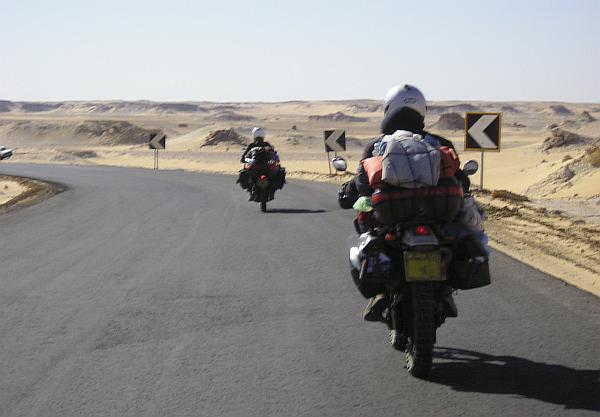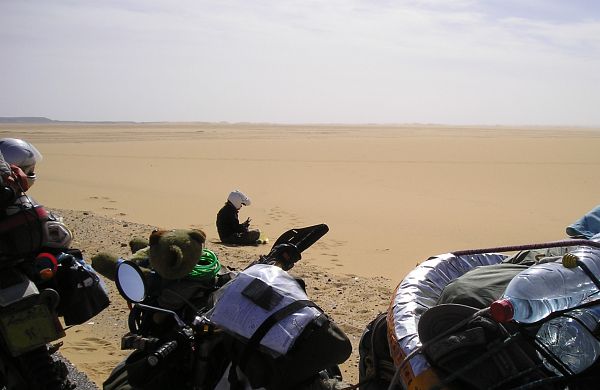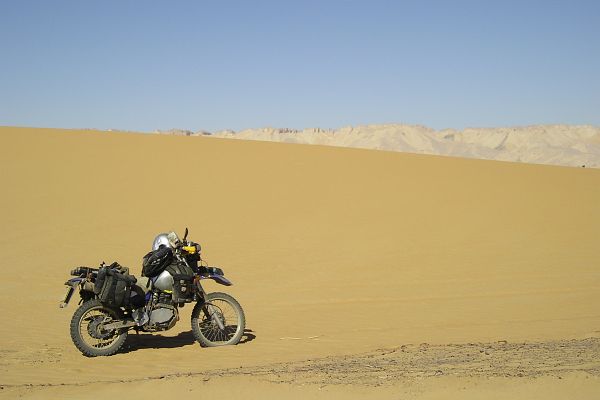Footprints In The Saharan Sand
We arrived in Luxor yesterday (Jan 17th) after riding around the Western Desert for the two weeks since leaving Cairo.

Approaching the White Desert (part of Egypt's Western Desert) after staying a couple of nights in the Bahariya Oasis.
I fitted a camera clamp to the little screen on my bike and took a few 'action' photos while on the move. Most were a blurred smudge.
Caroline in front, Beau behind, 5 litre petrol cans strapped either side of his number plate.

We camped in the White Desert. So-called because of the large quantity of chalk deposits and white chalk rock formations, carved by the wind into all sorts of fantastic shapes, from a few feet high to fifty feet or more.

Our campsite, under 'The Acacia Tree'
And it's a funny thing, but the different shapes seem to be congregated into groups of similar appearance. As these rocks don't have legs, how do they do that?
Thus there is a huge area called The Mushrooms, where all the rocks are carved by the wind into mushroom-like shapes. Nearby is an equally huge area called The Tents, where the chalk rocks resemble nomads' tents. And so on. As the same wind blows through all the White Desert, how did these rocks become grouped together?
More mysteries.
Unknown to me, some considerable time ago on this trip, the bolt holding the chain guide roller in place, immediately behind the gearbox on my bike, fell out.
By some quirk, when the guide roller itself fell out, instead of dropping onto the road it must have lodged somewhere in the area between gearbox, mudguard and swing-arm, where it's had a free ride since. Miles of shaking and bumping over all sorts of tarmac and dirt roads didn't dislodge it, but we are approaching areas of steadily worsening roads where it will certainly be shaken out and lost forever.
So, as I was unaware of this situation, and the guide roller will need to be back in place for those bad roads, what is fate's answer?
Fate - that mysterious force that decides what will happen, whatever we think.
Well, there's a lot of sand in the Sahara, so while camping in the White Desert we thought we'd ride around some of it, taking in all the amazing shapes of the wind-carved chalk rocks on the way.
The chalk, in lots of places, is flat and appears in large areas just above the sand, or in others, just an inch or so below, or elsewhere there's no chalk at all, just sand. So, riding around between the rock structures, the surface constantly changes between firm chalk, firm sand just above the chalk, and soft sand varying between soft and, errr, far too soft for our heavily-loaded bikes.
It was fun trying out these different riding surfaces, and not so much fun pulling the bikes out when stuck in the deep bits. At one point Caroline and Beau decided to stop riding and walk around a bit - a funny thing to do when you're on a motorbike journey - so I carried on down a track not yet explored.

Caroline and Beau park in the White Desert and decide on some 'walking'.
As confidence built up and the surface became easier to read, I found myself zooming along in third gear.
Then fate stepped in. It steered me across an area of deep sand, leading to old tyre tracks and firm chalk beyond. But via a deep hidden sand-hole far too soft for my momentary lapse of concentration.
The handlebars went one way, I didn't compensate, and fate laid my fully-loaded bike - camping gear and all - down in the sand on its right-hand side, with me completely alone.
Oh dear.
But there's the opportunity here for a test, can I pick the bike up on my own? Under the searing desert sun? Charlie and Ewan style bikes need at least three men to pick them up, or a crane towed behind the support truck.
I removed the spare tyre, some water, a roll bag and the tent, and my helmet and riding jacket. And heave-ho and up she rises. Back to the vertical. So not bad at all.
And what's this in the sand, where the bike has just been resting on its side? Round and black and grubby.
It looks like a chain guide roller!
What an amazing coincidence, someone's lost a roller right where my bike parked itself on its side!
Hold on - let's nip round to the other side of my bike for a look.
Hey! My guide roller's gone! And Ive found another one right here in the Saharan sand! How did that happen??
The Footprints In The Sand.
(Anyone not familiar with this little story can find it through an internet search if they want).

Just as I thought that I was all alone riding in the Sahara, there was Fate. Deciding that I needed to be told that my roller was no longer attached to my bike, before we reached the bad roads and it fell out altogether. (And it needs to be fixed back in place for the bad roads, to prevent the bumps and jolts from sending the chain striking against the top of the gearbox housing).
So very kindly, Fate sent me hurtling towards the hidden sand hole and laid the bike over on its right so that the black roller fell out of its hidey-hole straight onto the white sand. And of course I immediately saw it once the bike was upright again. How clever is that!
After playing in the sand some more and wearing ourselves out we rode the short distance to Farafra Oasis for the night.

Afternoon tea on the way to Farafra. 'Tent' formation behind.
My bike was on its side shortly before this.
And no, after I realised I'd picked the thing up before taking a photo of it lying down, I was not going to lie it down again just for the camera!
The following morning we set off for the longer ride to the Dakhla Oasis. Tantalisingly, that road skirts the very edge of The Great Sand Sea, truly a legendary area of the Sahara.

At the water's edge of The Great Sand Sea.

Contemplation On The Sand Sea.
At a stop for some photos another amazing coincidence. A rider on a Honda Africa Twin coming from the opposite direction stops for a chat. He departed Cape Town six months ago and is nearing the end of his journey to his home in Alexandria. He introduces himself as none other than Omar Mansour, a regular contributor to the help and advice columns on this HorizonsUnlimited website, and provider of assistance to overland bikers all over Saharan East Africa.
At the side of the road Omar gives us all sorts of useful information for our way ahead. From where to find easy sand dunes at the Dakhla Oasis, to how to plan our first couple of days riding after crossing from Ethiopia into Kenya on the notorious Moyale to Marsabit road. This road is famed for breaking bikes (and cars) in half, requiring a long and expensive lift in the back of a pickup truck to the nearest welders, normally in Nairobi.
So we thank Omar for his advice and keep our fingers crossed.
But fate was still lurking. That evening we stopped in El Qasr, in the Dakhla oasis, and took most of the luggage off the bikes. The next morning we planned to explore the local sand dunes recommended by Omar earlier in the day.
And the next morning - Pow! - Wallop! - Montezuma's Revenge enters stage right with a vengeance. That is, it makes a devastating direct hit on Beau, a glancing blow on Caroline and misses me.
So we have a day of chores instead. In the afternoon when Caroline was back in circulation (but Beau was right out of action the entire day and part of the next), we removed all air filters for cleaning, a nasty sort of job involving rinsing them clean in petrol then soaking them in oil. And fitting the new tyre on Caroline's front wheel.
And would you believe it? Fate is there again.
With old tyre off and new one ready, we pumped some air into the inner tube just to check. What's that hissing? A tiny hole! And a check in the old tyre revealed quite a length of steel pin protruding inside. The removal of tyre and tube must have just pushed it enough to penetrate right through the 4mm thick rubber of this super-heavy-duty inner tube.
And would you believe it? Mohamad, the ebullient owner of the hotel we are staying in, arrives and introduces his friend Mohammad, owner of the tyre repair shop across the road. "Mohammad will repair that very good, with heated vulcanizing machine. Better than your patch and rubber glue. He does excellent job for my guests!"
So Mohammad of the tyre repair shop took over and did it all for us.
And that was interesting in a way. Because he had never seen a tyre security bolt (or 'rim-lock' if you're younger) before. But dealt with it quite expertly.
The last time that happened to me was in northern Finland, also on a Serow (my old one) and the tyre man there had never seen a security bolt before either. He wanted to remove it altogether, said the tyre couldn't be put back on if it stayed there. I ended up having to fit the tyre myself in his garage.
Finland 0 : Egypt 1

The day after fitting Caroline's new tyre, with Beau still not well, Caroline and I explore the 'easy' dunes near El Qasr.

But I decide in the end that our bikes with little engines, road gearing and heavy luggage are not good, or even no good, for riding in soft sand. There's insufficient torque at the rear wheel to get moving without putting the clutch in serious danger of destruction. Even when we fit our smaller gearbox sprockets later in the journey.
And even riding down these little dunes in first gear, full throttle was needed to maintain momentum through the sand.
Perversely, the local riders (Chinese 250cc bikes are tremendously popular in the towns and villages of Egypt) get around on the sand with little trouble. They have lots of experience, and road tyres, which spin easily in the sand saving the clutch on take-off. Our knobblies grip so well that no spin is possible. Even on full throttle the engine stalls with a worrying burst of pinking.
So we are now in Luxor, seeing some sights, but mainly preparing for the long haul between the Egypt/Sudan border at Aswan, and Nairobi. Petrol, water and internet will be in short supply. Beau now has ten litres of petrol cans strapped to his bike, which we tested in the Western Desert. We think that will be enough.
We also need to jetison some stuff - that is, some weight. What stuff we don't yet know, but stuff will have to go......
Also, I needed to repair my chain guide roller. I unbolted the roller from Beau's bike, which is the same, and found that I had not only lost the retaining nut and bolt but also the simple ball bearing inside.
We are staying at a camp site in Luxor popular with long-distance overland travellers and the owner is used to travellers preparing their vehicles for the difficult stretch to Nairobi. I asked if he knew of a place that could do a repair. He consulted with his son, a lengthy conversation in Arabic, and said finally, "Jump on the back of his bike, he'll take you to a good place!"
Well, having been pillion riding around Cairo for Caroline's new tyre, Luxor promised to be easy-peasy.
We zoomed along for maybe a couple of miles zig-zagging around horse-and-carts and stopped outside a typical (that is, decrepit) lock-up, housing a small "we do anything" mechanic's workshop. Just like my garage but with an enormous lathe in the back and an enormous pillar drill in the front.
The owner examined Beau's roller, the remains of mine, and on dismantling the bearing inside Beau's, made that Egyptian "pppppszzz" sound - that you hear a lot and that can mean anything.
He mounted his bicycle, signalled "wait here" and pedalled off down the lane.
Presently he returned, fished some bits out of his pocket, and I found out what "pppppszzz" means.
It means, "This is pretty crude, no wonder it fell apart, this bearing just isn't up to the job, it needs a proper sealed journal pressed into it, I'll get two, one to replace your lost one and one to replace this inadequate thing in your son-in-law's guide roller."
And that's what he did!
Followed by his machinist making up a new spacer to replace my lost one and producing replacement nut, bolt and washers out of the company's junk box.
All for three UK pounds, and we have decent bearing journals now for the rough road ahead.

The remains of my roller, left. Beau's roller with bicycle-wheel-style ball bearing, right.
(That's an ashtray behind holding them in the right pose)

Smart new sealed journals in both rollers, mine all repaired on the left.

And all fitted back in place.
So our plan now, should internet not be available for a while, and just to make Fate laugh, is to ride down the Nile road to Aswan in a couple of day's time, and take the Monday (25th Jan) ferry that crosses Lake Nasser and the Sudanese border to Wadi Halfa, passing Abu Simbel on the way. The ferry is a once-a-week affair, taking 18 hours. But vehicles go on a separate barge which can take up to three days.
Thence our road follows the Nile and its villages to Khartoum, continuing onwards across the border with Ethiopia and on to Addis Ababa.
There should be internet somewhere in that lot.
Not only that, but 25th January is Burns night. Let's hope there's a well-prepared Scottish contingent on the ferry to show all the Egyptians, Sudanese and English a thing or two.
Please post a haggis to McCrankpin, c/o Wadi Halfa Ferry Terminal, Aswan, Egypt.
